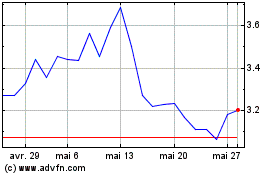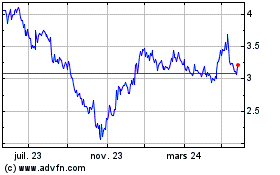Transforming the Built Environment with Circular Design Technology
26 Août 2024 - 3:00PM

Aquafil SpA (ECNLF:OTCQX – ECNL:IM), based in Arco
(TN) Italy and a pioneer of the circular economy, today released
its second in a series of monographs that illustrate how we can
design better to do better.
The potential for technology to revolutionize
the way we live and work is boundless. In this context, the
intersection of sustainability and technology presents a compelling
growth opportunity. Companies that prioritize eco-design and
circular manufacturing practices are not only driving positive
environmental outcomes but also positioning themselves at the
forefront of a rapidly expanding market segment. But, in the
context of circular design, the key drivers of this transformation
are not just AI or advanced tools, but the designers,
manufacturers, and producers who wield them. True power for change
lies within the human mind, capable of reimagining and reshaping
design. When creative minds and cutting-edge technology come
together, the opportunity to transform industries is
immense—especially within the built environment. Aquafil is an
industry leader with a legacy of innovation in sustainable design,
exemplifying how businesses can capitalize on these trends. The
kernel of all change is concept and design. In the circular
economy, therefore, it all starts with design, and here are some of
the ways design can support circular technology.Stage 1:
Designing with the End in MindEco-design is the process of
minimizing environmental impact by designing a product with
circularity in mind at inception. While designing a product,
consider what is going to happen at the end of its life – tossed
into a landfill, or recycled into new ingredients for new
designs?One of the essential elements is to design products where
its materials are easily separated and recycled after use at the
design stage. This means making it easy to remove the nylon tufts
from carpet backing, or separating the metal zipper from a nylon
jacket so the nylon can be recycled or, better, regenerated.Not
only do products need to be creatively designed to be easily
separated, but the technology that can produce these eco-designed
pieces also needs to be developed. For instance, Aquafil started
with the flooring industry where it launched the R2R project in
partnership with our customers to co-design the environmental
friendly flooring of the future.Stage 2: Creating Circular
IngredientsThe world has become reliant on plastic
products, which are made by extracting oil and gas, and are often
designed to only be used once. Every year, millions of tons of
plastic ends up in landfills or, worse, irresponsibly dumped into
our oceans. There is an opportunity to reduce our reliance on
resource extraction and eliminate waste by creating circular
plastic ingredients. Aquafil has developed ECONYL® regenerated
polymers that can also be used in place of hard plastics made from
oil. The versatility of ECONYLⓇ regenerated polymers makes the
ingredient ideal for injection molding, extrusion and production of
products like chairs or frames for sunglasses.
The beauty of these polymers is that, unlike the
limited life of most plastics that are recycled, they can be
infinitely regenerated for endless use - circular. In addition, the
development of this technology not only reduces production waste
but also aligns with global sustainability goals—trends that are
increasingly important to both consumers and regulators.
Stage 3: Developing Circular
Manufacturing Practices
Once we have a product made of recyclable
ingredients that can easily be separated for continued recycling
and regeneration, we need a circular manufacturing model to reduce
waste during production. One of the latest technologies getting
interest is circular additive manufacturing, or 3D printing.
3D printing currently only makes up about 1% of
the global manufacturing market, but it is set to grow
exponentially. This is a great opportunity for designers to utilize
3D printing to create more sustainable products since it is an
additive process, meaning it builds a product by adding materials
as needed rather than creating waste by removing what isn’t
needed.
In addition to reducing the amount of waste
during production, 3D printing can also reduce waste by enabling
designers to create more effective prototypes through the digital
system, make and replace parts as needed, and manufacture in
multiple locations instead of shipping from one central plant. 3D
printing can be even more sustainable when designers elect to print
with recycled plastics, like ECONYL® regenerated polymers and
filaments. To evolve into a truly circular economy we must continue
to learn and innovate, that is why Aquafil, in the last year alone,
invested almost 2% of revenues in R&D.
Do not miss the latest updates by tuning in to
the Aquafil Group’s 1H 2024 Results which will be presented on
Thursday, 29th August 2024 at 12.00 PM ET, live on YouTube (the
link to the conference call will be available on the IR calendar:
https://www.aquafil.com/investor-relations/financial-calendar/).
About Aquafil SpA
Since 1965, the Aquafil Group has been a pioneer
of the circular economy and a landmark in terms of quality and
product innovation for Italy and the globe. We primarily
manufacture Nylon 6 fibers and polymers but also Nylon 6.6 and
Dryarn. Our flagship product is ECONYL® nylon, which revolutionizes
the world of synthetic fibers through a closed-loop model.
Today, Aquafil remains a leader in the research
of new production systems for sustainable development.
To keep current on Aquafil, please go to
www.aquafil.com.
Investors ContactGiulia Rossi
investor.relations@aquafil.com mob: +39 327 0820.268
Media Contact Maria Giovanna
Sandrini maria.giovanna.sandrini@aquafil.commob: +39 348
6019.628
U.S. Contact:Joe Hassettjoeh@gregoryfca.commob:
610-787-0464
Aquafil (BIT:ECNL)
Graphique Historique de l'Action
De Oct 2024 à Nov 2024

Aquafil (BIT:ECNL)
Graphique Historique de l'Action
De Nov 2023 à Nov 2024


